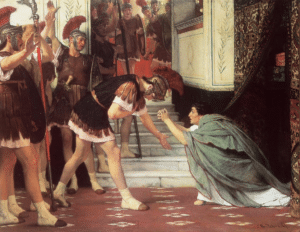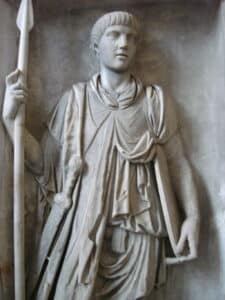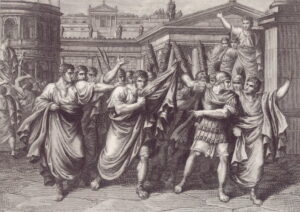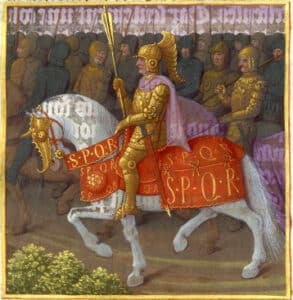Caligula. Commodus. Pertinax. Caracalla. And, of course, who could forget Pupienus? These are just some of the Roman emperors who ended their reigns (and their lives) at the hands of the Praetorian Guard. Although it was an elite unit meant to serve as bodyguards for the emperor, the Guard looked after its own interests, first and foremost. If anyone clashed with those interests, then they could be marked for death, even if they happened to rule over the Roman Empire.
Many emperors feared the Praetorian Guard and went to great lengths to stay on its good side. Famed 18th-century historian Edward Gibbon decried “The Praetorian bands, whose licentious fury was the first symptom and cause of the decline of the Roman empire.” But was it true that a single military unit wielded so much power and had that much influence on the history of Rome? Let’s find out…

The Republican Origins
Although the Praetorian Guard as an official unit appeared at the outset of the Roman Empire, its origins lie in the 3rd century BC, during the time of the Republic. Back then, certain military commanders called praetors thought it would be a good idea, in certain situations, to protect themselves with temporary bodyguards.
We’re not sure how big these units were at first, but we do know that, in 133 BC, during the Siege of Numantia, General Scipio Aemilianus formed one such unit out of 500 men, or about the size of a cohort. This was unusually large and was commented on by his contemporaries, and from that point on, such bodyguard contingents became known as cohors praetoria, or Praetorian cohort.
The Praetorians did not have many moments of glory during the Republic years, but they did step up to the plate in 62 BC, during the failed coup attempt known as the Catiline conspiracy. Here’s a quick rundown: a politician named Lucius Sergius Catilina, or simply Catiline, instigated a plot to take over the republic by overthrowing the two Roman consuls in charge at the time, a guy called Gaius Antonius Hybrida and Cicero.
Eventually, Cicero exposed the conspiracy. Catiline was forced to flee Rome to where his army was sitting and waiting, while his co-conspirators were caught and executed without trial on Cicero’s orders. Historians have debated whether or not he was in the right doing this, and this is a subject we’ll discuss in-depth in our future bio on Cicero. Stay tuned for that one. Anyway, all of Catiline’s allies were dead, but he still had an army so he thought – why not? If he were caught, he would be executed, so he might as well try to take down the government. Consequently, Catiline’s army fought the Republican forces led by Marcus Petreius at the Battle of Pistoria, in early January 62 BC.
Catiline only had a few thousand soldiers. We’re not sure how many Petreius had; we just know that it was more, so he started the battle with a significant advantage. Here’s the thing, though – all of Catiline’s men were veteran legionaries who fought under Sulla and had seen plenty of action. They were kicking the asses of the Republican forces and were on the verge of victory but, in a moment of inspiration, Petreius called up his praetorian cohort from the reserve and together led a charge right into the center of the enemy line. Catiline’s soldiers fought fiercely until the last man, but the praetorians outshined them that day. A rare moment when we have something positive to say about them. Not a lot more to come.
The Birth of the Praetorian Guard

We now advance a few decades to a time of great turmoil for Rome. It was 44 BC – years earlier, Julius Caesar had launched a civil war that saw the fall of the Republic and his ascent as dictator of Rome. But then he was assassinated during the Ides of March, and it was up to his former allies to avenge him, mainly Octavian and Mark Antony. During that time, both men had large Praetorian cohorts that numbered in the thousands, all loyal veterans recruited from the ranks of Caesar’s soldiers. Ultimately, Octavian and Antony triumphed against Caesar’s assassins in the Liberators’ civil war and, alongside Lepidus, formed the Second Triumvirate to rule over Rome. But they didn’t get along with each other, either, and, after a lot more fighting, eventually Octavian emerged alone on top of the mountain. He took the name Augustus and, in 27 BC, began his reign as the first emperor of the newly-formed Roman Empire.
Augustus liked his praetorians since he learned firsthand from Caesar the advantages of having an army at your disposal that was loyal to you, personally, instead of your position or your rank. Plus, now that the armies of Rome weren’t divided between various factions fighting each other anymore, he had soldiers to spare. So he formed the first permanent bodyguard unit tasked with protecting himself and the royal family and it was called the Praetorian Guard. Or we called it that, to be more exact. The term is a modern one, while the Romans called it cohors praetoria just like before. That brings us to an interesting question – just how many soldiers were there in the Praetorian Guard?
There’s no definitive answer since the number changed a lot throughout the Guard’s 300-year history. We know that the Guard formed by Augustus consisted of nine cohorts of approximately 500 men each, so it originally had 4,500 soldiers…ish. However, that number would change almost immediately as the emperors who followed kept adding cohorts, while others removed them. At its peak, the Praetorian Guard had 15,000 soldiers.
Because he didn’t want to be seen as a military tyrant, Augustus only stationed three cohorts in Rome, while the rest were quartered in other towns throughout Italy, but still close to the capital. However, this, too, would change soon enough, once the praetorians had their own barracks built on the outskirts of Rome called the Castra Praetoria.
Recruitment of praetorians was done mostly from Italian ranks, although the records show that some recruits came from other lands such as Germany, Thrace, and Pannonia. And while the bodyguards during the Republic era were all veteran soldiers, Augustus preferred to recruit young men from good families and this became the norm going forward, barring a few exceptions here and there.
Service in the Praetorian Guard started out at 12 years but was bumped up to 16 still during the reign of Augustus. Most days, being a praetorian was a pretty sweet gig, so it wasn’t surprising that the soldiers wanted it as long as possible. However, we should point out that the sole duty of the praetorians wasn’t just to follow the emperor around. Some of them acted as speculatores – basically, spies – and gathered intelligence, engaged in espionage, made arrests, and even performed assassinations in order to safeguard the emperor and protect the interests of the empire. There are a few mentions in the historical record that, on occasion, the praetorians also helped out with more mundane tasks, such as assisting the fire department to put out a fire, or serving as crowd control during the arena games.
There is one noteworthy event that stands out – the naumachia staged by Claudius in 52 AD. A naumachia was a mock naval battle, organized the same way as gladiator or animal fights except, you know, in water. They were much rarer events simply because they were a lot more expensive, time-consuming, and required more bodies for the slaughter, but the spectacle staged by Claudius was almost as grand as the real thing. Taking place on Lake Fucino, this naumachia involved 100 ships and 19,000 men, all of them condemned criminals who would have been executed anyway. This way, if they fought bravely and pleased the crowds, some of them might have had a shot at a reprieve. On this occasion, the praetorians got involved in the games themselves, stationed around the lake on rafts and ramparts armed with catapults just in case the convicts got any funny ideas.
Fun history fact for you: Suetonius wrote that, at the start of this naumachia, the criminals shouted at Claudius Ave imperator, morituri te salutant, or something to that effect, meaning “Hail, emperor, those who are about to die salute you.” In modern times, this has become known as some sort of greeting that gladiators addressed to the emperor before fighting, but this is the only known example of this phrase in the historical record, and it took place during a naumachia, not an arena fight, and it was said by convicted criminals, not gladiators. So sorry, but this probably was not a common salute in ancient times, although the AC/DC version still applies.
The Praetorian Guard Gains Power

After Augustus was gone, it didn’t take long for the Praetorian Guard to gain a lot more power than it should have, and it was all thanks to a devious and ambitious rascal by the name of Sejanus.
When Augustus formed the Praetorian Guard, he put two people in charge of it called praetorian prefects. He was then followed on the throne by his stepson Tiberius who, although an effective administrator and even a successful general in his younger days, lacked the determination, willpower, and charisma of his stepfather to be a forceful leader. Therefore, he passed along a lot of his responsibilities to Sejanus, who served as praetorian prefect; and he did it solo, by the way, he didn’t have a co-prefect. And then, in 26 AD, after the deaths of the emperor’s son and nephew, Tiberius retired to the island of Capri and allowed Sejanus to become the de facto ruler of the empire.
Sejanus was a villain through and through with an unquenchable lust for power. In fact, he was such a scoundrel that he might get his own bio one day. He tried to marry into the royal family multiple times, without success. When that didn’t work, historian Tacitus openly accused him of poisoning the emperor’s son, Drusus, so that Tiberius wouldn’t get any ideas of ceding power to him. Once Sejanus was in charge, he controlled almost all the communication that reached the emperor in Capri, and he began a purge of rich and powerful Romans who might pose a threat to him.
After years went by when Tiberius hadn’t been seen in the capital, most people accepted Sejanus as the leader of Rome – he got engaged to a member of the royal family; there were statues erected in his honor, and his birthday had even become a holiday. Sejanus felt like he was untouchable…and then…he wasn’t.
Something happened towards the end of 31 AD and Sejanus was summarily arrested and executed. Frustratingly, we’re not sure what because that part of Tacitus’s account is missing. Centuries later, however, Cassius Dio wrote that Tiberius finally found out about all the shenanigans Sejanus had been up to, so he had him secretly replaced as praetorian prefect and then had him arrested with the help of the cohortes urbanae – essentially, the Roman police.
As praetorian prefect, Sejanus enacted multiple reforms that benefited the praetorians – he was the one who built the Castra Praetoria and brought all the cohorts into Rome to have them nearby in case things got hairy. In the centuries that followed, the office of praetorian prefect would gain more functions and benefits, basically becoming one of the top aides of the emperor. However, few of them would ever hold as much power as Sejanus.
Kingmakers and Kingslayers
At this point, the Praetorian Guard was only a few decades old and, already, it had become fairly obvious that it might wield a little too much power. But this was only the beginning because the praetorians went on to have a much more direct and drastic effect on the course of Roman history when they began straight up assassinating old emperors and installing new ones as they saw fit.
This happened right after Tiberius, who was followed on the throne by the infamous Caligula. To be fair, Caligula wasn’t exactly a people person so there were plenty in Rome who wanted him dead. But it was two praetorians named Cassius Chaerea and Cornelius Sabinus who actually got the job done and stabbed the emperor to death. But then there was some dissension within the ranks of the Guard. Chaerea was in league with the Senators who wanted to restore the Republic, but the other praetorians feared this would cause them to lose power. Instead, they looked for a suitable new emperor among the royal family. Not an easy thing to do since Caligula killed most of them, but they found him in Claudius, an uncle who was never seen as much of a threat because he had several physical disabilities. But the Praetorian Guard wasn’t picky, so they acclaimed Claudius as the new emperor and then forced the Senate to accept him.
At least, on this occasion, the Guard killed a murderous nutjob and supported a guy who turned out to be a pretty good emperor. We’ll add it to the “good” column, even if it was unintentional since the praetorians did it to save their own jobs. But let’s look at what happened after Claudius – another whackjob followed him you’re probably familiar with named Nero.
Emperor Nero was cool with the Guard for the first decade of his reign. He kept them happy and they turned a blind eye to all of his extracurricular activities. But eventually, the people had had enough and everyone started to turn on the emperor. When he found himself with no allies left, Nero killed himself, and with him died the Julio-Claudian Dynasty. No more obscure uncles to proclaim emperor this time, and this led Rome into a succession crisis known as the Year of the Four Emperors.
When Nero was still alive, his praetorian prefect, a guy called Gaius Nymphidius Sabinus, convinced the Guard to turn on the emperor and support a contender for the throne named Galba in exchange for money. Then there was a strange interlude after Nero was dead but before Galba had arrived in Rome when Sabinus had a change of heart and decided that he should be emperor, after all. However, the other praetorians disagreed and killed Sabinus, firmly convinced that Galba was the right man for the job…and that the job meant paying them lots of money.
Here’s the thing, though – when we say “lots of money,” we mean it. Sabinus promised the praetorians 7,500 sestertii per man and 1,250 sestertii for those in service outside of Rome. According to Plutarch, this was “a sum which it was impossible to raise without inflicting ten thousand times more evils upon the world than those inflicted by Nero.” Unsurprisingly, Galba didn’t have it, and after a few months of stalling, the Guard got tired of waiting and turned on him on the way to the Roman Forum. As the soldiers approached to kill the emperor, only one praetorian stayed loyal – a centurion by the name of Sempronius Densus who tried, in vain, to protect Galba and received a fatal wound to the groin for his efforts.
So now Galba was dead and the Praetorian Guard sided with the new guy – Otho. Many of the guards smeared their clothes and swords in Galba’s blood and went up to Otho claiming they were the ones who killed the emperor. A hundred and twenty of them gave him written petitions for rewards and those would come in handy just a little later.
Unfortunately for the praetorians, they backed the wrong horse on this one. Remember, this is still the Year of the Four Emperors, and we’ve only had two, so far. The third one, Vitellius, was on his way to Rome to challenge Otho and, after winning at the Battle of Bedriacum, Vitellius became the new emperor and Otho committed suicide.
One of the first things that Vitellius did was to disband the entire Praetorian Guard and form a new one using trusted soldiers from the ranks of his own army. And all those praetorians who wrote petitions claiming they murdered Galba? He had them all executed, which goes to show that it was true back then just as it is now – if you’re going to commit a crime, don’t leave a paper trail.
In theory, disbanding the original Guard was a smart thing to do. The old one clearly could not be trusted. However, Vitellius just created a large armed force with no leader, that also hated him. Where was it going to go? Unsurprisingly, it joined up with the fourth and final contender to the throne, Vespasian.
The two sides fought at the Second Battle of Bedriacum and, after some praetorian-on-praetorian action, Vespasian emerged triumphant while Vitellius was dragged out of the palace and executed on the streets of Rome.
Quiet, Chaos, Killings & Conclusion

With Vespasian on the throne, his Flavian Dynasty brought some much-needed stability to Rome. He kept the Praetorian Guard, although he took multiple steps to minimize any potential risks. He reduced the Guard’s size back to nine cohorts again, he recruited soldiers from the ranks of Otho, Vitellius, and his own army, and he installed his son, future emperor Titus, as the praetorian prefect.
These moves worked well and, for the next 100-plus years, there wasn’t much written about the praetorians. Unsurprisingly, this coincided with a period of strong leadership for Rome – first, the Flavians, and then the Nerva-Antonine Dynasty, or the so-called Five Good Emperors. Sure, there were still some hiccups – both of Domitian’s praetorian prefects, Titus Petronius Secundus and Titus Flavius Norbanus, were implicated in the emperor’s assassination, but at least the other praetorians were angry about it and killed Secundus to avenge Domitian. We’re not sure what happened to Norbanus.
Other than that, the praetorians were mostly used as regular soldiers during this period, most notably during Trajan’s campaigns against Dacia and Parthia. But that changed when Commodus assumed power and the Guard was up to its old tricks again. Under his reign, the leaders of the praetorians gained massive influence and used it to enrich themselves and get rid of opponents, particularly a guy called Cleander and the praetorian prefect Laetus who helped plot Commodus’s assassination and the rise of the new emperor, Pertinax. But Pertinax got it into his head that the Guard needed more discipline and tried to reform it. Unsurprisingly, the praetorians didn’t like that, so they killed Pertinax, too, just three months into his reign.
After that, the Praetorian Guard made, arguably, its ballsiest move yet, even more so than assassinating an emperor which, let’s be honest, someone had to do it – they auctioned off the Roman Empire. Basically, at that point, whoever the Guard wanted as emperor would become emperor since they were the most powerful military force in Rome, and they decided to give their support to the highest bidder after a bidding war outside the Castra Praetoria.
The winner was Didius Julianus and his grand prize was to serve as Roman Emperor for two whole months before being killed, as well. If it’s not out already, look out for a bio on him soon to cover this shameful episode in detail, described by Cassius Dio as the “most disgraceful business and one unworthy of Rome.”
After Julianus came the Severan Dynasty. Its founder, Septimius Severus, tried to reform the Praetorian Guard again by disbanding the old Guard and creating a new one with soldiers from his army, but it didn’t last. During the reign of his son, Caracalla, the praetorian prefect Macrinus plotted the emperor’s murder and then successfully proclaimed himself the new emperor, ruling for one year before being executed. And then, guess what? The guy who followed him, Elagabalus, was also killed by the praetorians. Then he had his head chopped off and his body stripped naked, dragged through the streets, and thrown in the river. So not a very popular guy…
A decade-and-a-half later, during the Year of the Six Emperors, two co-emperors, Balbinus and Pupienus, were also killed by the Praetorian Guard. We talked about this recently in our bio for Maximinus Thrax, but we brought it up just to have an excuse to say Pupienus again.
After that came the Crisis of the Third Century, a period of great turmoil and instability for the Roman Empire. There wasn’t much written about the Praetorian Guard during that time, probably because there was chaos all around so their shenanigans didn’t stand out as much.
The only notable episode left in the history of the Praetorian Guard was its demise, which came at the hands of Constantine the Great. And yes, we are definitely going to do a bio on him, too. During the early 4th century, Constantine was embroiled in a civil war with two other emperors – Maxentius and Licinius. Maxentius had the support of the Praetorian Guard, but they bet on the wrong horse again. Constantine defeated him in 312 AD, at the Battle of the Milvian Bridge, where Maxentius drowned in the river Tiber.
After that, Constantine realized that the Praetorian Guard was beyond redemption and did what, probably, another emperor should have done hundreds of years earlier – he permanently dissolved the Praetorian Guard in 313 AD. He destroyed the Castra Praetoria and whatever praetorians were left, he distributed among legions in the far corners of the empire. And thus, after four centuries of conspiracies, betrayals, bribes, and assassinations, the Praetorian Guard was no more, although it had already left an indelible mark on history.





